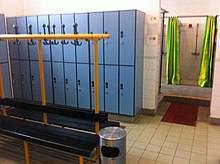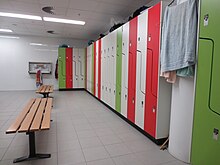What Stores Have Cameras In The Dressing Rooms

Changing room within a sports hall
A changing room, locker room, dressing room (unremarkably in a sports, theater or staff context) or changeroom (regional use) is a room or area designated for changing one'southward clothes. Changing rooms are provided in a semi-public situation to enable people to change apparel with varying degrees of privacy.
Separate changing rooms may be provided for men and women, or at that place may be a non-gender-specific open up infinite with individual cubicles or stalls,[1] every bit with unisex public toilets. Many changing rooms include toilets, sinks and showers. Sometimes a changing room exists every bit a small portion of a restroom/washroom. For example, the men's and women'southward washrooms in Toronto'southward Dundas Square (which includes a h2o play area) each include a change area which is a bare counter space at the end of a row of sinks. In this example, the facility is primarily a washroom, and its apply as a changing room is minimal, since just a small percentage of users alter into bathing suits. Sometimes a person may change their wearing apparel in a toilet cubicle of a washroom.

Larger changing rooms are usually found at public beaches, or other bathing areas, where virtually of the infinite is for changing, and minimal washroom space is included. Embankment-fashion changing rooms are often large open rooms with benches against the walls. Some do not have a roof, providing just the barrier necessary to forestall people outside from seeing in.
Types [edit]


Various types of changing rooms exist:
- Irresolute stalls are pocket-size stalls where clothes tin can be inverse in privacy. They are used for any concrete activity.
- Locker rooms are usually gender-specific spaces where clothes are changed and stored in lockers. They are often used for swimming or other sporting purposes. They are open spaces with no stalls. These rooms include toilets, sinks, and showers.
- Fitting rooms, or dressing rooms, are unremarkably small unmarried-user cubicles where a person may effort on clothes. These are oftentimes plant at retail stores where 1 would want to try on clothes earlier purchasing them.
- Green rooms and trap rooms are normally mixed-gender backstage or under-phase changing spaces found at theaters and other similar venues.
Changing stalls [edit]
Irresolute stalls are small stalls where clothes can exist changed in privacy. Apparel are usually stored in lockers. At that place are usually no separate areas for men and women. They are often combined with gender-separated communal showers. Almost public pools have irresolute facilities of this kind alongside communal changing rooms.
Communal changing rooms [edit]

Lockers and bench in changeroom
Locker rooms are thus named because they provide lockers for the storage of i'due south belongings. Alternatively, they may have a locker room attendant who will keep a person'due south belongings until one comes to call up them. Locker rooms are ordinarily open spaces where people change together, just there are separate areas, or separate locker rooms, for men and women. Sometimes they are used in swimming complexes.
Locking devices used in locker rooms accept traditionally been key or coin lockers, or lockers that are secured with a combination lock. Newer locker rooms may be automated, with robotic machines to store clothes, with such features as a fingerprint scanner to enroll and for later retrieval. Locker rooms in some water parks use a microchip equipped wristband. The aforementioned wristband that unlocks the lockers can be used to purchase nutrient and drinks and other items in the h2o park.
Some communal changing rooms are only supposed to be used by groups of persons, not individuals. In this example, at that place may be no lockers. Instead, the entire room is locked in society to protect property from theft.
Locker rooms are also used in many center schools and high schools. Most of them include showers for after Physical Education.
At an outdoor sports facility, the changing rooms may exist integrated into a pavilion or clubhouse, with other facilities such equally seating or a bar.
(Shop) plumbing fixtures rooms [edit]

A changeroom in a department store

A block of habiliment store fitting rooms in Denmark

Changeroom sign in article of clothing store
Fitting rooms, or "dressing rooms", are rooms where people endeavor on clothes, such every bit in a section store. The rooms are usually individual rooms in which a person tries on clothes to determine fit earlier making a purchase. People do not always use the fitting rooms to change, every bit to change implies to remove i set of dress and put on some other. Sometimes a person chooses to try on clothes over their clothes (such as sweaters or coats), merely would even so like to do this in private. Thus fitting rooms may be used for changing, or just for plumbing fixtures without changing.
Rules and conventions [edit]
Retail establishments often post rules such as maximum number of items immune in changing room, e.g. "no more than than iv items allowed in changing room".
History [edit]
It appears that the offset store fitting rooms appeared with the spread of department stores.[ii] Émile Zola noted their existence in his novel Au Bonheur des Dames (1883), and that they were and then forbidden to men.[2] Some years afterwards, when Henri Gervex, who painted Jeanne Paquin in 1906, that was no longer the case.[ clarification needed ] [2]
In any case, Buster Keaton worked in one in an American 1928 silent one-act The Cameraman.[ii] Since then, they have continued to provide comic scenes in films, for example in the 1995 French picture show Les Trois Frères.[2]
Greenish rooms [edit]
A light-green room is a room located backstage in a theatre or some such performance space where the actors (musicians, dancers etc.) expect before they go onstage. I theory of its naming is that it traditionally has green walls; as green is considered to have a calming effect and is meant to bring focus before the functioning and at-home nerves. Another is that performers in the dark-green room are "Greenish to go", gear up to continue stage. Green rooms are usually located backstage, but sometimes nether the stage, or to the side, they can as well be located anywhere where there is room to put a communal space. In exhibition halls and convention centers, Pipe and Pall "rooms" may exist constructed as a Green rooms. Greenish rooms are unremarkably not separated by gender, considering performers ofttimes modify in separate, unremarkably gender separated, dressing rooms and congregate in the Greenish Room, once largely or completely in costume to assistance each other focus and calm fretfulness of other performers. Dark-green Rooms may be separated by performing grouping, or the main headliner may have their own Green Room, and the supporting acts share another. Green rooms are oft also used on non-show days and during the install and strike of productions equally a break room or meeting room, and may contain a refrigerator, microwave, coffee motorcar, or water fountain.
Endeavour rooms [edit]
Most ready-fabricated wear shops, especially those in the big shopping malls, take ane or more fitting rooms, which are designated booths or try rooms that enable customers to try on clothing to check its size, condolement, and suitability for buy.
Dressing rooms (domestic) [edit]
In larger Victorian houses it was common to have a private room called a boudoir for the lady of the house that is attainable from the bedroom, and also a dressing room for the gentleman[iii] (and sometimes a man's cabinet).
Cleansing stations [edit]
Before the advent of modernistic plumbing, in that location existed a number of places for washing one's clothes and trunk. Cleansing stations were separated by gender, and combined the function of cleaning dress with cleaning of the body. The closest modernistic equivalent would exist a combination laundromat plus locker room with showers.
During the nineteenth, and early on part of the twentieth century, the increase of urbanization caused an increase in the spread of disease. Poor hygiene was adamant to be the cause. Since many families did non have practical ways to clean themselves or their apparel, public cleansing stations were established for their apply.
Security [edit]
Because of the privacy afforded by changing rooms, they create a trouble in the trade off between security and privacy, where in information technology may exist possible for criminal offence to be perpetrated by people using the cover of privacy to sell drugs, or steal habiliment from a department shop. Some department stores take security cameras in the changing rooms.[4]
Communal irresolute rooms pose less of a take chances of theft than fitting rooms, considering at that place is not full privacy. In item, the perpetrator of a crime would not know whether or not other users might be hugger-mugger police or security guards. Many modern changing rooms often have labyrinth-style entrances that have no door, and so that people outside cannot see in, but security can walk in at any time without the sound of an opening door alerting persons inside. Washrooms in which changing clothes is merely a secondary purpose often besides have such labyrinth openings. Many washrooms accept security cameras in the main area with a view of the sinks and the urinals from a viewing angle that would only show the back of a user. However, when a washroom is located near a fountain, wading pool, or the like, and is likely to be used for irresolute apparel, some believe that washroom surveillance cameras would exist a violation of privacy.
Another security risk present is that of theft. Sometimes no method of securing items is provided, but even lockable lockers or baskets are unremarkably designed for only minimal security assuasive experienced thieves to steal the valuable items which people typically have with them before irresolute.[5] [vi] Changing room operators oftentimes mail service signs disclaiming responsibility for stolen items, which can discourage but non eliminate claims for negligence.
Encounter also [edit]
- Virtual dressing room
References [edit]
- ^ Queen Elizabeth Puddle, Edmonton, Canada Archived September 27, 2013, at the Wayback Machine
- ^ a b c d due east «Essayer en corps. Sociologie des cabines d'essayage », Thierry Caro, mémoire de fin d'études à l'Institut d'études politiques de Lille, 2004.
- ^ Yorke, Trevor (2005) The Victorian House Explained. Newbury: Countryside Books ISBN 9781846748233; p. 105
- ^ Come across Phil Patton'southward article "Y'all don't have to smile", excerpt included in Netcam Privacy Issues for more on security cameras in irresolute rooms
- ^ "Gym Locker Theft in Bangkok". Archived from the original on 2013-03-13.
- ^ "Mysterious gym locker theft leads to string of troubles".
External links [edit]
-
 Media related to Dressing rooms at Wikimedia Eatables
Media related to Dressing rooms at Wikimedia Eatables
Source: https://en.wikipedia.org/wiki/Changing_room
Posted by: markshowere.blogspot.com


0 Response to "What Stores Have Cameras In The Dressing Rooms"
Post a Comment